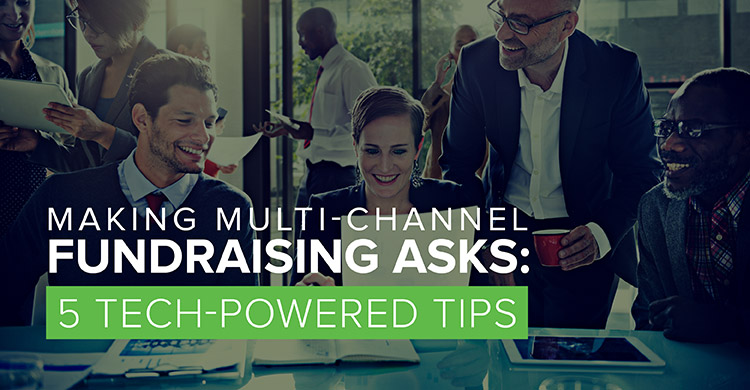-
Software
Compliance Software
Oversee licenses, track renewals, access documents, and more from a single interface.
Software Overview -
Services
Compliance Services
Full service compliance solutions for organizations throughout their entire lifecycles.
Services Overview -
Industries
-
Partner
- Information Center
Making Multi-Channel Fundraising Asks: 5 Tech-Powered Tips

Does it feel like your nonprofit’s fundraising efforts are focused on just one or two channels? For most organizations, there are a handful of fundraising channels that get prioritized over all others when it’s time to make solicitations.
While this works for some, the reality is that most organizations are missing out on donors by narrowly focusing on only digital fundraising, event fundraising, or face-to-face asks.
If your team wants to diversify your donor community and reach your fundraising goals this year, you’ll need to think about adopting a multi-channel fundraising strategy.
In this article, we’ll review our favorite ways to make multi-channel asks and connect with your donors wherever they are. Even better? With smart nonprofit technology, making meaningful, data-driven connections with supporters has never been easier.
Get the ball rolling on your multi-channel fundraising efforts by checking out our top strategies:
- Start by sharing your online fundraising form across digital channels.
- Engage social media-savvy supporters with peer-to-peer fundraising.
- Promote text-to-give fundraising to smartphone users.
- Enable supporters to give through Facebook.
- Strengthen solicitations by leveraging intelligent donor data.
When your nonprofit takes a comprehensive approach to multi-channel fundraising, you’ll grow your community of active givers while learning more about what actually inspires them to give.
1. Start by sharing your online fundraising form across digital channels.
By now, your nonprofit is bound to have implemented a digital fundraising form that you share on your website through your Ways to Give page. However, if this is the only place your fundraising form lives online, you’re missing out on potential givers!
To make the most of your digital fundraising channels (including email, social media, and your nonprofit’s website), consider each an opportunity to spread your online fundraising form across the internet.
You can make savvy digital asks by:
- Sharing the link as part of a call to action in the bottom of your nonprofit’s weekly newsletter email stream.
- Periodically posting the link in the description of social media videos urging your supporters to make a donation.
- Linking to your online donation form in your website’s running footer as a way to secure gifts from all kinds of site visitors.
Want to bridge the gap between more traditional fundraising channels (like direct mail) and digital ones? Try adding your online fundraising page link to your direct mail communications, or a QR code that links to your form when scanned!
Bonus tip! Looking for ways to improve your online fundraising form? Try adding gamification tools like a fundraising thermometer to get people excited (and inspired) to make their gift.
2. Engage social media-savvy supporters with peer-to-peer fundraising.
Social media is one of the most active fundraising channels on the internet. If your nonprofit isn’t taking the time to optimize how you engage with supporters on social sites, you’re certainly missing out on significant fundraising revenue.
However, it’s not enough to simply share your online fundraising form with social media users. In fact, there’s a smarter way to raise money through social media channels: peer-to-peer fundraising.
Peer-to-peer fundraising works like this:
- Your nonprofit empowers supporters to set up customizable (but branded) fundraising pages that they’ll use to fundraise on behalf of your cause.
- Volunteer fundraisers share these fundraising pages across their social media profiles so that they end up in the newsfeeds and timelines of their friends, family, and coworkers.
What sets peer-to-peer fundraising apart from other digital fundraising strategies is that it opens up your community of supporters.
When you make a peer-to-peer fundraising ask, you give individuals the choice to donate today, or to use their platform to fundraise for your nonprofit. This makes your peer-to-peer fundraising channel a truly dynamic pathway to giving, both for supporters and your team.
3. Promote text-to-give fundraising to smartphone users.
Another tech strategy to make smarter fundraising asks is opening up your nonprofit to text-to-give fundraising. By enabling text-to-give for supporters, you gain access to them wherever they are, whenever they’re inspired to give.
When your nonprofit adopts text-to-give technology, you’ll be able to make quick and convenient asks via your supporters’ smartphones.
Since this giving channel is so instantaneous, it’s a great way to promote spontaneous giving among your supporters. For example, you could promote your text-to-give fundraising channel at events following an inspiring speech or presentation.
Or, you might share information about your text-to-give program across email and social media channels as an educational strategy.
When these interested supporters read your latest post or email on the subject, they’re likely to make a gift right then and there or remember the channel the next time they’re especially inspired to give but aren’t near a computer.
The bottom line? Since so many of us have our smartphones on hand 24/7, your nonprofit is missing out on a really robust fundraising channel if you haven’t yet invested in text-to-give software.
Bonus tip! Want to learn more about text-to-give fundraising? Visit Qgiv to access an extensive text-to-give guide to learn the ins and outs of this smart technology.
4. Enable supporters to give through Facebook.
Now, we’ve already reviewed a few ways to maximize social media as a fundraising channel for your nonprofit. But, we haven’t yet talked about our favorite way to fundraise on social media. That is, fundraising through sites like Facebook.
Focusing on Facebook as a distinct fundraising channel has many benefits, but they all basically boil down to increasing the convenience of giving. Since your supporters are already there, it makes sense to make giving as easy as possible on the site.
There are two main ways to leverage Facebook as a fundraising tool:
- Your nonprofit could start using “Donate” buttons on your Facebook page. These are fundraising terminals that process gifts through Facebook’s fundraising interface.
- Your team could add your online fundraising form to your profile. With the right software, you can empower donors to seamlessly give through your official form without leaving the site.
Because Facebook is such a social media powerhouse, it’s crucial to think of it as an entirely unique fundraising tool. However you choose to process gifts through the website, you can be confident that you’re reaching one of your largest supporter constituencies (and their friends, too).
5. Strengthen solicitations by leveraging intelligent donor data.
One of the biggest benefits of applying a tech-focused fundraising strategy is that you’re able to learn more about your donor community than ever before.
Your fundraising software tools capture meaningful data on supporters through every interaction, and your team should put this data to use to hone your multi-channel fundraising efforts. You can start improving your strategy by optimizing your donor database.
In your donor database, your team should collect the following information on your constituents:
- Biographical data including their birth date, address, contact information, and more.
- Professional affiliations such as their employer and networking groups they belong to.
- Social media personas such as their Facebook profile, Twitter handle, and Instagram account.
- Giving indicators including net worth, real estate holdings, stock ownership, etc.
- Propensity indicators like their history of supporting other nonprofits.
When you have access to this kind of data in your constituent profiles, your team can strengthen your multi-channel fundraising strategy by promoting certain giving and engagement channels to different segments of your community.
For example, younger supporters who have made frequent small gifts to your cause are great candidates for social media giving. Alternatively, older professionals may be more suited to direct asks via mail or through email channels and prefer to give to larger campaigns, like your capital campaign.
The most important part of strengthening your multi-channel fundraising strategy, however, is learning from your experiences with donors. Not only should you keep extensive data profiling these individuals, but you should also maintain a record of what fundraising and marketing channels were actually successful when engaging with supporters.
On paper, certain constituents might seem like they’d be responsive to one kind of ask, but that doesn’t mean they won’t actually prefer a different channel or solicitation strategy. Only time will tell, and as long as you keep and analyze your donor data, eventually you’ll better understand what makes your community tick.
When your nonprofit applies smart nonprofit technology and data-driven strategies to your multi-channel fundraising efforts, there’s nothing that will get in the way of achieving your goals. With these tips on hand, you’re ready to get out there and make more effective asks!

Abby Jarvis is a blogger, marketer, and communications coordinator for Qgiv, an online fundraising service provider. Qgiv offers industry-leading online giving and peer to peer fundraising tools for nonprofit, faith-based, and political organizations of all sizes. When she’s not working at Qgiv, Abby can usually be found writing for local magazines, catching up on her favorite blogs, or binge-watching sci-fi shows on Netflix.





